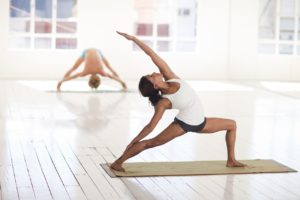Yoga offers many exercises on balance. Off the mat, it explains balance in life: in one’s intake, relationships, ethics, emotions, etc. On the carpet, yoga’s most obvious lesson in balance is the difficulty of finding real equality in different asanas. The following steps will assist you to find and keep your perspective when developing your own yoga practice!
#1: “Discover Drishti”
You may have previously been directed to “find your drishti” in adjusting poses. Drishti is a gazing procedure where the yogi concentrates their attention and eyesight on one point. It helps in concentration, so it is sometimes trained as a meditation procedure. Practicing drishti on the mat will help control your equilibrium.
Before starting a balancing asana, concentrate the gaze on one fixed spot. Utilize this focus to get your sense of inner stability. In standing position asanas, like tree pose, prefer a location directly ahead of the mat. In regular balancing poses, like the half-moon or warrior three, center the gaze on the ground. In inverted postures, like headstand, prefer a point on the ground one to two feet apart.
Test the power of drishti by coming into tree pose. Notice the difference in balance when keeping the eyes focused on one point ahead versus darting the sights nearby the room. Drishti works!
(For more, try The 9 Drishti of Yoga.)
#2:”Take Benefit of Yoga Props”
Yoga aids may make it simpler to balance as you build your belief. Yoga blocks are individually helpful because they bring the floor closer when tight tissues prevent the deep stretches needed for balance. The idea is to use props as mechanisms to open the body and teach proper alliance rather than become addicted to them.
A block placed below the lower hand in half moon posture or elongated side angle pose, for example, can promote balance. Begin with the block on its most magnificent setting with the small end of the block on the ground. Work with this adjustment for a week. Then, fix up the block so that it is somewhat lower with the most significant, thinnest surface of the block on the floor; again, going with this modification for a couple of weeks. Ultimately, you will be capable of removing the block entirely.
#3: “Utilize Breath”
The breath is a powerful mechanism for balance as it steadies the mind and clarifies focus. It’s fascinating to hold one’s breath in challenging adjusting asanas, like dancer’s posture or headstand, but this is when the motivation is required most. Keep the breathing rhythmic, slow and deep with each asana you do.
The breath can be strategically applied to enter, hold and exit asanas. In general, inhale when lifting the body. For illustration, when creating a dancer’s posture from mountain posture, inhale as the leg is elevated from the floor. Conversely, exhale when dropping the body. For example, emit when loosening the foot to the level in tree pose. This kind of synchronization of the breath invites focus, steadiness, and sleekness of action.
#4: ”Go Gently”
Regularly take your time when transferring in and out of adjusting asanas. Hold the urge to shoot your legs up when starting a headstand quickly. Newcomers usually make this mistake, but this kind of unusual movement makes it difficult to find equilibrium in the final posture. Instead, move gently and mindfully. Begin the asana with a feeling of ease, and you will be more likely to control that ease in each pose you do.
#5: “Endure Fluctuations”
If you exercise yoga often, it becomes noteworthy that flexibility shifts on a day-to-day base. The same thing occurs with stability. It may have been a piece of cake to handle tree posture for a minute yesterday, but today the pose is shaky after only some seconds.
This is common. Stability tends to fluctuate. If one’s equilibrium is off one day, try not to become frustrated. Alternatively, maintain a sense of curiosity. Hold the temptation to look throughout the room at what others are creating. Put your drishti on your mat. Don’t allow judgment to rise facing yourself or others.
#6: “Hold at It”
If you lose stability in an asana, the best stuff to do is come right back into the posture. Yoga is a constant practice and enhancement occurs through repetition. Drop out of the pose, take a breath in the opening asana, and try again.
Direct your gaze and breath constant, take advantage of props, move mindfully, and recognize that your practice will update from one day to the next. Once you gain natural balance on the mat, your sense of balance will penetrate your entire being — even reaching to your mind and sensations for balance off the mat.
No Prep Yoga Plans for yoga teachers provides all the tools you need to create a holistic yoga class in minutes.





